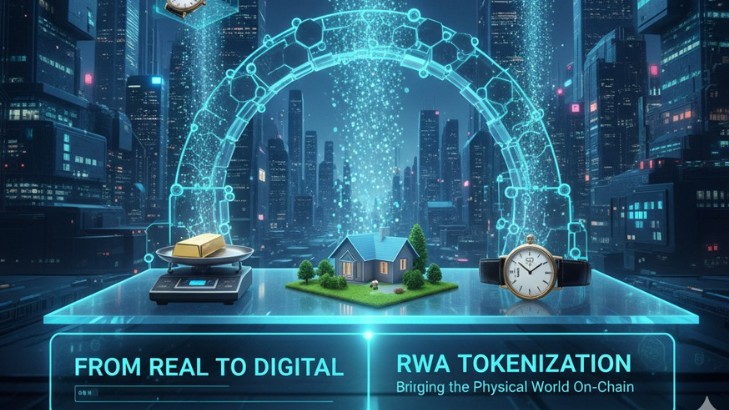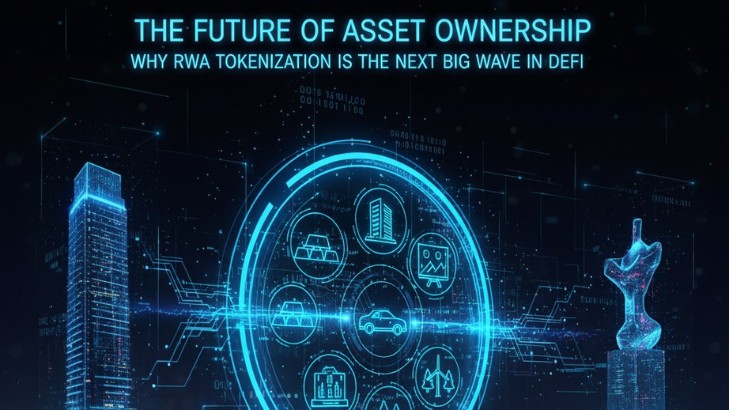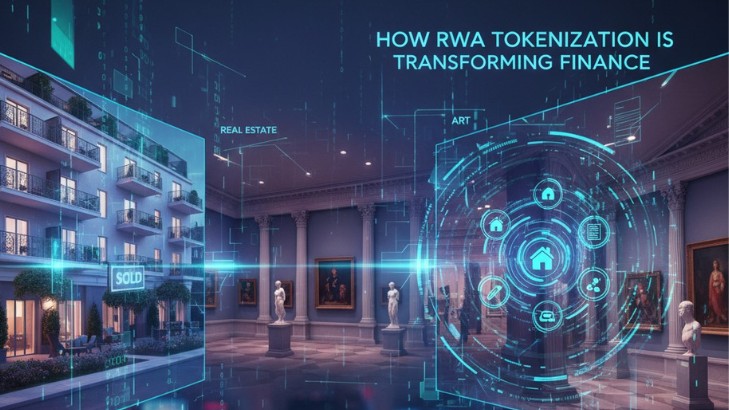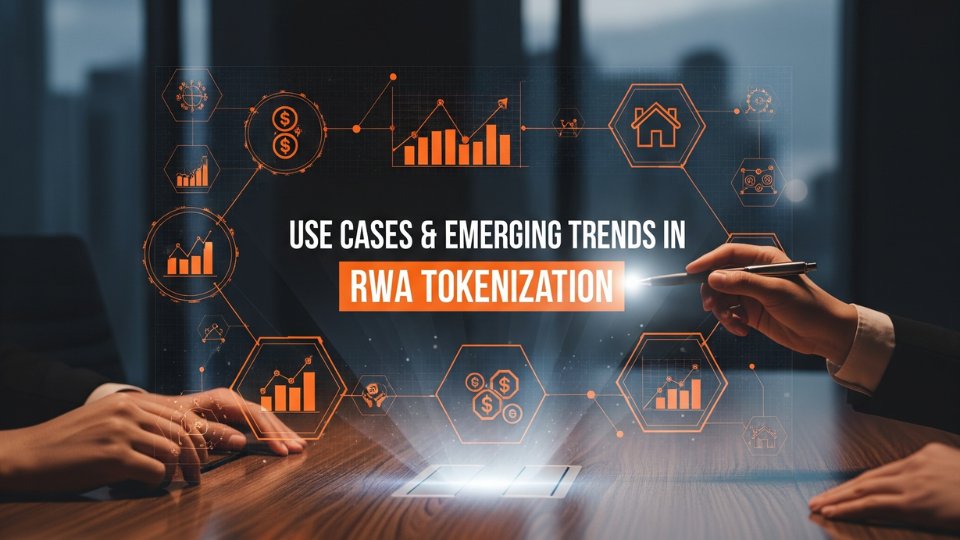From Real to Digital: How RWA Tokenization Is Bringing the Physical World On-Chain
October 7, 2025



There has been a lot of excitement in recent years about how blockchain technology can go beyond cryptocurrencies and DeFi to represent actual physical or off-chain value. One of the most promising vectors of this transformation is Real-World Asset (RWA) tokenization — the process of representing ownership (or rights) in physical or traditional financial assets on-chain via tokens. By doing this, we can unlock liquidity, lower barriers to entry, and make many asset classes more transparent, programmable, and inclusive. But the road is not without its obstacles.
This article will explore what RWA tokenization is, how it works, its benefits, the challenges, real world use cases, regulatory and technical considerations, and where this trend seems to be heading.
What Is RWA Tokenization?
At its core, RWA tokenization is the process of converting rights to a physical or off-chain asset into digital tokens on a blockchain. Those assets can include things like:
- Real estate
- Commodities (e.g. gold, rare metals)
- Art and collectibles
- Private credit (loans, receivables)
- Bonds, equities, and financial securities
- Physical goods in supply chains
These tokens may represent full ownership, fractional ownership, or income rights from those assets. The goal is to create a “digital twin” of the real asset — something that is legally tied to the underlying asset, but lives on a blockchain, enabling transfer, splitting/fractionizing, trading, or other programmable interactions.
There are two broad kinds of RWA tokens often distinguished:
- Native RWA tokens: These are tokens that represent assets issued directly on-chain, where the token itself is the asset (or ownership vehicle) from inception. For example, a bond that is issued as a token on a blockchain.
- Non-native RWA tokens: Tokens that represent or mirror an off-chain asset, but much of the physical asset remains managed off‐chain (e.g. via custodians). The token is a legal or contractual proxy. Many real estate, art, or commodity tokens follow this model.
Why Tokenize Real Assets?
Tokenizing real-world assets (RWAs) is far more than a passing trend — it represents a fundamental shift in how ownership, access, and value are managed in both physical and financial markets. One of the most significant advantages of tokenization is liquidity. Traditionally, assets like real estate, fine art, or private equity have been difficult to trade due to high entry costs and long transaction processes. By turning these assets into digital tokens, they can be divided and traded more easily on blockchain-based secondary markets. This fractionalization allows investors to buy or sell portions of assets rather than entire properties or artworks, thereby unlocking liquidity in markets that were once stagnant. Closely tied to this is the concept of fractional ownership, which enables broader participation by lowering the barriers to entry. Instead of requiring millions to purchase a building or invest in a private equity fund, tokenization lets individuals own a small, proportional share of the same asset — democratizing access to investment opportunities that were once reserved for the wealthy elite.
Another major benefit is transparency and trust. Through blockchain’s immutable ledger, every transaction and ownership transfer is recorded permanently, creating an auditable and tamper-proof history. When combined with real-world data oracles and properly structured legal frameworks, this transparency ensures a verified chain of custody and provenance, reducing the risk of fraud, double ownership, or disputes over titles. Moreover, tokenized assets gain additional value through programmability. Smart contracts — self-executing agreements coded directly into the blockchain — allow assets to carry embedded rights and automated functions such as revenue distribution, dividend payments, voting rights, buyback mechanisms, and even compliance checks. This means that once the rules are written into code, they are automatically enforced without the need for intermediaries, minimizing errors and human bias.
Tokenization also paves the way for broader access and global democratization of investment opportunities. It allows investors from around the world, subject to regulatory guidelines, to gain exposure to asset classes and markets that were previously geographically or financially out of reach. For instance, someone living in Asia could own a fractional share of a commercial building in New York or an artwork in Paris — all through secure, blockchain-based transactions. Beyond access, operational efficiency and cost reduction are also major drivers. Traditional asset transactions often require multiple intermediaries — brokers, custodians, notaries, and banks — each adding complexity, paperwork, and fees. Tokenization simplifies this process by automating verification, reducing manual intervention, and cutting administrative overheads, leading to faster settlements and lower costs. Finally, tokenized markets bring the potential for 24/7 trading, unlike conventional financial markets limited by time zones and business hours. Digital tokens can be traded continuously, with near-instant settlement times, giving investors more flexibility, responsiveness, and global reach.
In essence, tokenization transforms real-world assets into dynamic, liquid, transparent, and programmable digital instruments — bridging the gap between traditional finance and the decentralized, always-on digital economy.
Key Challenges & Risks
While real-world asset (RWA) tokenization holds tremendous potential, it is not without significant challenges and risks that must be addressed before mainstream adoption can occur. The foremost concern lies in legal and regulatory uncertainty, as the legal frameworks governing ownership, securities, and property rights vary widely across jurisdictions. What constitutes legal ownership in the traditional, off-chain world must be carefully mirrored on-chain to ensure enforceability and investor protection. Many regulators classify certain tokenized assets—especially those offering profit expectations or fractional ownership—as securities, which brings obligations like registration, licensing, and disclosure. Sudden regulatory changes or ambiguity can stall projects, restrict investor participation, or even render existing tokens noncompliant overnight. Closely related to this is the issue of custodial and custody risk, particularly when dealing with tangible physical assets like real estate, gold, or fine art. These assets require trustworthy custodians to hold and manage them, and if a custodian loses, damages, mismanages, or absconds with the asset, the associated tokens instantly lose value. For financial assets like bonds or funds, the same risk exists at the administrative level—strong legal contracts, insurance coverage, and transparent auditing are essential to mitigate such vulnerabilities.
Another complex challenge lies in maintaining a reliable link between the token and its underlying asset. For tokenization to hold real value, each token must represent a verifiable, enforceable claim to the real-world asset it symbolizes. Weak documentation, unclear legal agreements, or poor data feeds from oracles can create uncertainty about ownership or value. If the proof of ownership is not airtight, token holders could face disputes or lose their rights entirely. Valuation and price discovery further complicate matters, since many physical or private assets lack the kind of continuous market activity that helps determine fair value. Without regular appraisals or sufficient market liquidity, prices can fluctuate wildly, and investors might face wide bid-ask spreads or artificial volatility. In early stages of adoption, liquidity bottlenecks are also common. Even though tokenization enables fractional trading, many token holders tend to hold their assets long-term, leading to shallow market depth and low trading volumes. Secondary markets are still emerging, and as academic studies have shown, many tokenized assets experience minimal trading activity, which hampers efficient price discovery and investor confidence.
From a technical standpoint, smart contract vulnerabilities and oracle failures pose another major risk. A single coding bug, data bridge malfunction, or compromised oracle can undermine the integrity of an entire system, potentially freezing funds or allowing fraudulent transactions. Moreover, blockchain networks themselves are not immune to issues—network congestion, high gas fees, or limited scalability can make frequent or small transactions impractical, eroding the user experience. On top of that, regulatory and compliance overhead adds considerable complexity. Implementing Know Your Customer (KYC), Anti-Money Laundering (AML), and tax reporting requirements demands sophisticated frameworks that balance transparency with privacy. Jurisdictional restrictions, whitelisting of approved investors, and regulatory permissions can all constrain how freely tokens can move or be traded, reducing some of the efficiency that tokenization promises.
Finally, one of the most subtle yet impactful barriers is trust and perception. For many traditional investors, the concept of owning blockchain-based tokens that represent real-world assets feels unfamiliar and risky. Concerns about the credibility of custodians, enforceability of ownership rights, technical reliability, and potential for fraud remain prevalent. In a developing ecosystem, even a few high-profile failures or cases of mismanagement can undermine trust and slow adoption across the entire industry. Therefore, building confidence through transparency, sound regulation, robust governance, and strong custodial and technical safeguards is critical for tokenization to truly transform real-world asset markets.
Current Real-World Examples & Use Cases
To ground the theory, here are some real examples of RWA tokenization in action, showing both what is possible and some of the early pitfalls.
- Real Estate Tokenization
- Some real estate properties (commercial or residential) are being fractionalized and tokenized. Investors can own shares in large buildings, rental properties, etc., and receive income (rent) as token holder. This model allows smaller investors to benefit from real estate returns without owning entire properties. For example, platforms have tokenized luxury condos, warehouses, etc.
- Tokenized Private Credit, Bonds, and Financial Securities
- Traditional financial instruments like bonds, private loan receivables, or debt are being brought on-chain. For example, tokenized treasury bills, or private credit funds, are increasingly used as RWAs. BNB Chain’s RWA solutions include tokenizing T-Bills, real estate, private credit etc. One example is BlackRock’s BUIDL Fund, issued via Securitize, which is a large tokenized treasury fund. Also, private credit funds and institutional funds have been issued on-chain via regulated platforms.
- Commodities and Physical Goods
- Gold, precious metals, art, collectibles, rare items are being tokenized. For example, Klaytn has gold tokenization initiatives.
- Art, Collectibles, Luxury Goods
- Fractional ownership of fine art or collectibles is emerging. Platforms like Savea or firms working in the space allow people to own fractions of artworks or luxury assets.
- Stablecoins / Tokenized Cash and Treasury Assets
- Although stablecoins are slightly different, many stablecoins are backed by off-chain assets (fiat or short-term treasuries) and can be viewed as one of the largest classes of tokenized real-world value. Also, tokenized funds that mirror treasury bills or money market instruments are growing.
- Hybrid Digital-Physical Ownership Models
- Some projects use tokens that grant rights to physical items (redeemable or not), or allow physical goods to be exchanged via on-chain proof, or ownership certificates. Also, systems using oracles to reflect condition/status or usage of assets (such as cars, property condition, etc.).
Regulation, Standards, and the Legal Bridge
Converting something tangible into a token isn’t enough; there must be legal enforceability. Some of the key legal and regulatory components are:
- SPVs / Trusts / Special legal vehicles to isolate and manage assets legally.
- Contractual agreements that tie the token ownership with rights to the underlying asset.
- Custody law: physical assets need safe, insured storage and legal chain of custody.
- Securities law compliance: many tokens will be deemed securities under local laws, so disclosure, licensing, registration, and oversight may apply.
- Identity, AML/KYC: to satisfy regulations and prevent fraudulent transactions.
- Standards and token protocols: e.g. specific token standards that include permissioning, identity, transfer restrictions, etc. (e.g. ERC-3643 is one example for permissioned token standards)
Regulators are increasingly taking notice. Some jurisdictions are encouraging tokenization. Others are cautious, issuing guidance or restrictions. For example, Hong Kong has been a hotspot for RWA tokenization interest, but has also seen regulatory pause or scrutiny.
Empirical Market Size, Trends & Data
The rise of real-world asset (RWA) tokenization is no longer theoretical — it is already unfolding at a remarkable pace, backed by measurable growth and accelerating adoption across global markets. According to multiple academic and industry studies, by the middle of 2025, more than US$25 billion worth of RWAs had already been brought on-chain, signaling a tangible shift from traditional ownership models to blockchain-based representations of value. This includes a growing array of assets such as tokenized U.S. Treasury bills, corporate bonds, real estate, commodities, and private credit instruments. In another report, the value of tokenized RWAs — excluding stablecoins — was estimated to have reached approximately US$15.2 billion by the end of 2024, marking an impressive year-over-year increase of roughly 85%. Such strong growth rates highlight how tokenization is rapidly gaining traction among institutional investors, fintech innovators, and even traditional banks looking to leverage blockchain for efficiency and transparency.
When stablecoins and tokenized funds are factored in, the overall scale of tokenized value becomes even more substantial. Stablecoins alone — which represent fiat currencies like the U.S. dollar in digital form — already account for hundreds of billions of dollars circulating on-chain, demonstrating that blockchain-based representations of real-world value are well established. This success paves the way for the next wave: the tokenization of less liquid and traditionally complex asset classes. The momentum is further reinforced by projections from major consulting and financial advisory firms, many of which predict that the RWA tokenization market could expand into the trillions of dollars by the end of this decade. Some forecasts even suggest that tokenized assets might represent a significant portion of the world’s GDP by 2030, reshaping how capital formation, investment, and asset management operate globally.
These empirical trends collectively underscore a crucial reality: RWA tokenization is well beyond the experimental or pilot phase. It is evolving into a full-fledged financial infrastructure layer that bridges traditional finance (TradFi) and decentralized finance (DeFi). The growth trajectory mirrors that of early internet adoption — slow at first, then exponential — as trust, regulation, and infrastructure mature. With expanding regulatory clarity, institutional onboarding, and continuous technological improvement, the tokenization of real assets is poised to become one of the defining financial transformations of the coming decade.
Challenges & What’s Slowing Adoption
Despite its immense potential, RWA tokenization has yet to achieve widespread adoption, and a variety of technical, legal, and market-related challenges continue to slow its progress. One of the most immediate obstacles is weak liquidity across many tokenized assets. While numerous projects have issued tokens representing real estate, credit instruments, and other assets, only a small fraction of these tokens see regular trading activity. Many investors prefer to hold rather than trade, and the number of active buyers and sellers remains limited. As a result, markets often suffer from low trading volumes, high bid-ask spreads, and inefficient price discovery, which in turn dampens investor confidence. Beyond liquidity, asset diversity and scale also pose serious barriers. Certain asset types — such as physical property in emerging economies, perishable commodities, or complex private equity structures — are much harder to tokenize effectively. Expanding tokenization to encompass a broad range of assets across multiple jurisdictions introduces significant operational, legal, and technical overheads, making scalability a major challenge.
The cost of compliance and legal structuring further limits adoption. Tokenizing real assets requires extensive due diligence, legal documentation, regulatory filings, audits, and ongoing maintenance costs related to custodianship, insurance, and monitoring. For smaller or lower-value assets, these expenses can outweigh potential benefits, making tokenization economically impractical. Compounding this issue is the lack of standards, interoperability, and cross-chain consistency. When tokenized assets of similar nature are issued on different blockchains, under varying legal frameworks, or with differing compliance standards, it leads to market fragmentation. Seamless cross-chain transfers, uniform identity verification, and standardized regulatory compliance are still difficult to achieve, hindering global liquidity and integration.
Another persistent challenge lies in valuation, oracle reliability, and transparency. Tokenized assets depend on accurate and up-to-date data from external sources, such as appraisers or IoT sensors, often transmitted through blockchain oracles. If these oracles are compromised, centralized, or unreliable, it can distort valuations or cause on-chain data to diverge from real-world conditions. Similarly, when the physical state of an asset changes — for example, damage to a property or shifts in underlying credit quality — updating the on-chain representation securely and transparently is a nontrivial task. Adding to this uncertainty are regulatory and political risks. Laws governing digital assets and property rights remain fluid, and evolving definitions of “security” or “ownership” can expose tokenization projects to sudden compliance challenges. In some jurisdictions, political resistance to decentralized ownership or cross-border capital flows adds another layer of unpredictability, as governments may impose restrictions or revoke permissions with little warning.
Furthermore, trust and legal enforceability are foundational yet often fragile components of RWA tokenization. Investors need clear assurance that their tokenized claims are legally recognized and enforceable in real-world courts. Weak or inconsistent legal documentation, gaps between on-chain contracts and off-chain realities, or disputes over custody and ownership can all erode confidence. Finally, user experience and infrastructure maturity remain underdeveloped. Many tokenization platforms are still in their early stages, with complex onboarding procedures and limited educational resources for users to fully understand their rights, risks, and responsibilities. High gas fees, slow transaction speeds, and network congestion can further degrade usability, making tokenized assets less attractive to mainstream investors.
Altogether, these challenges reveal that while RWA tokenization is a powerful innovation with enormous long-term potential, its path to widespread adoption requires coordinated progress in regulation, technology, interoperability, and user trust. Only with stronger legal foundations, deeper liquidity, and more intuitive platforms will the industry move from experimentation to global scale.
Some Noteworthy Platforms & Players
Here are a few organizations and projects that are already pushing forward with RWA tokenization:
- Securitize, Inc. — an end-to-end solution for tokenizing assets, offering issuance, investor onboarding, transfer agent services, fund administration, etc. They have issued billions in tokenized assets, including treasury funds, equities, and private credit.
- BNB Chain — has RWA tokenization solutions: transforming assets such as real estate, commodities, private credit, etc.
- Redbelly Network — built for compliant RWA tokenization with emphasis on identity verification, scalability, and regulatory alignment. Projects include tokenizing private equity, carbon credits, etc.
- Klaytn — working on tokenizing gold and physical commodities, among others, integrating RWA token issuance and using them in financial services.
- Centrifuge and others are building infrastructure that connects DeFi liquidity with tokenized real assets via oracles and asset originators.
Where This Is Headed: Trends & Predictions
Looking ahead, the evolution of real-world asset (RWA) tokenization is expected to be shaped by a combination of regulatory clarity, technological innovation, and expanding institutional participation. One of the most significant forthcoming developments will be regulatory maturation. As governments and financial authorities around the world gain a deeper understanding of blockchain-based asset representation, they are gradually building frameworks that clarify how tokenized securities, real property, and cross-border ownership should be governed. These evolving laws around digital ownership, custody, taxation, and dispute resolution will provide the legal certainty needed for large-scale adoption. Parallel to this, we can expect substantial progress in interoperability and cross-chain frameworks. Currently, most tokenized assets are siloed within specific blockchain ecosystems, but emerging technologies and standards will enable seamless asset transfers between networks while preserving legal identity, compliance, and ownership integrity. This kind of cross-chain functionality will not only enhance liquidity but also foster greater market cohesion and global participation.
At the same time, the industry will benefit from improved standards and protocols that unify how tokenized assets are issued, traded, and managed. Standardization around token formats, permissioning models, digital identity verification, vesting schedules, and oracle data feeds will simplify compliance, reduce risk, and make interoperability between projects far easier. As these technical and regulatory foundations strengthen, we’ll see scaling into more diverse asset classes. Beyond real estate and government bonds, tokenization will extend into infrastructure projects, intellectual property (such as music rights or patents), carbon credits, and supply chain assets — areas that can greatly benefit from increased transparency, liquidity, and accessibility.
Another major evolution will come from hybrid on-chain/off-chain financial products that blend decentralized finance (DeFi) mechanisms with tokenized real assets. Examples include yield-bearing tokens backed by tokenized bonds or real estate, on-chain collateralized loans using RWAs, and revenue-sharing mechanisms automatically distributed through smart contracts. These hybrid financial structures could redefine how credit, yield, and ownership work across both traditional and decentralized systems. Alongside these innovations, institutional participation is expected to accelerate. As legal and operational risks decline and custody solutions become more robust, banks, asset managers, and pension funds will increasingly integrate tokenized assets into their portfolios. This influx of institutional capital will further validate the ecosystem and drive liquidity.
Equally important will be advances in user tools, marketplaces, and overall user experience (UX). Future platforms will make it easier for both institutional and retail investors to list, trade, manage, and audit tokenized holdings. Enhanced interfaces, transparent legal frameworks, and simplified fractional trading mechanisms will help users clearly understand their ownership rights and investment risks. Finally, one of the most transformative outcomes of RWA tokenization will be greater economic inclusion and global exposure. By lowering the barriers to entry, tokenization can empower individuals in capital-scarce regions to invest in global real asset markets, participate in fractional ownership models, and channel diaspora capital into productive assets abroad. In this way, tokenization not only revolutionizes financial infrastructure but also democratizes access to wealth creation opportunities worldwide.
A Theoretical Walkthrough: Bringing an Apartment on-chain
To understand how real-world asset (RWA) tokenization might function in practice, imagine a commercial apartment building in Lahore whose owner wishes to raise capital while retaining control over the property. Rather than selling the entire building or taking out a loan, the owner decides to tokenize 40% of the building’s value, allowing investors to share in both rental income and capital appreciation. The first step is legal structuring, where a special purpose vehicle (SPV) is created to hold full ownership of the building. This SPV serves as the legal wrapper — a bridge between the on-chain tokens and the off-chain real-world property. It issues digital tokens representing 40% of the economic rights (such as rental profits and appreciation) while maintaining clear contractual terms that define investor entitlements, governance rights, and recourse under local property and securities laws. By doing so, the SPV ensures that each token corresponds to an enforceable legal claim recognized in the real world.
Next comes valuation, where an accredited property valuer conducts an independent assessment of the building’s worth based on current market rates, rental yields, occupancy trends, and projected maintenance costs. This valuation determines how many tokens will be issued and at what price. Custody and management of the asset remain the responsibility of the SPV or a trusted property manager, who oversees rent collection, maintenance, and tenant relations. These off-chain operational details are critical, as the physical asset ultimately backs the value of the on-chain tokens. To keep investors informed and ensure accountability, data bridging through oracles comes into play — real-world information such as rental income, property condition, and occupancy rates are securely transmitted to the blockchain. These data feeds update the associated smart contracts, which can automatically calculate and distribute returns to token holders.
Once the infrastructure is ready, on-chain minting occurs. The SPV issues a fixed number of tokens on a blockchain such as Ethereum or Polygon, each token digitally representing a share of ownership or profit rights in the SPV. These tokens are minted in compliance with know-your-customer (KYC) and anti-money laundering (AML) regulations to ensure all investors are verified and legally eligible. Distribution then follows, where the tokens are offered to both local and international investors. Thanks to fractionalization, even small investors can now gain exposure to Lahore’s real estate market without needing to buy an entire property.
As the market matures, secondary trading and liquidity mechanisms emerge. A permissioned marketplace — governed by the same compliance standards — allows token holders to sell or transfer their shares to others. Smart contracts automate the distribution of rental income, sending periodic payments directly to token holders’ wallets based on their proportional ownership. Meanwhile, compliance and reporting remain firmly anchored in traditional regulation: taxes are paid as required, audits are conducted, and all legal contracts retain enforceability under local and international law.
This model demonstrates the transformative potential of RWA tokenization. It enables fractional participation in high-value assets, provides investors with income streams and liquidity that traditional property markets rarely offer, and bridges the gap between real-world ownership and blockchain-based finance. By combining legal certainty, smart contract automation, and transparent data flow, tokenizing an apartment building in Lahore — or any similar real asset — can open entirely new pathways for inclusive, efficient, and borderless investment.
Potential Impacts & Why It Matters
Here are consequences and impacts this transformation could have on society, finance, and markets:
- Democratizing access to assets: Allowing smaller investors to access asset classes that were hitherto exclusive (real estate, art, commodities).
- Reducing friction and cost: Processes such as property transfers, title registration, brokerage fees, middlemen, etc., can be streamlined.
- Global capital flow: Investors across borders can participate more easily (subject to compliance). This could help capital flow into markets that have good assets but less access.
- Liquidity of traditionally illiquid assets: Real estate, art, private debt, etc., become more tradable; portfolios could become more diversified.
- Innovation in financial products: New ways to structure revenue sharing, micro-ownership, yield products, decentralized governance of assets, etc.
- Transparency & reduced fraud: Title disputes, provenance issues, double counting of ownership are reduced with immutable records.
- Potential positive environmental, social, or developmental effects: For example, tokenizing carbon credits, renewable energy infrastructure, or supply chain goods could help in ESG contexts.
Risks & What Could Go Wrong
It’s important to balance optimism with caution. Some of the risks and pitfalls include:
- Legal challenges / disputes: If legal contracts aren’t airtight, disputes over ownership or rights could arise.
- Custodian failure or theft: Physical assets might be stolen, destroyed, or lost; if the custodian is not strong, investors bear risk.
- Misvaluation or fraud: If oracles or valuation reports are manipulated, investors can be misled.
- Regulatory backlash: Governments might impose restrictions, change laws, or block certain cross border transactions.
- Technology risks: Bugs, hacks, data breaches could compromise token systems. Smart contracts or oracles failing could lead to financial loss.
- Illiquid markets or thin secondary trading: Even though fractional ownership is possible, without market participants, value could be hard to exit.
- Operational complexity: Maintenance, insurance, local governance, property upkeep, legal paperwork still need to be done.
Case Studies & Recent Developments
To see how theory is translating into practice, here are a few recent or ongoing developments:
- China / Hong Kong: There are property developers exploring RWA tokenization (e.g. Seazen Group establishing a digital assets institute in Hong Kong) to convert IP, asset income into tokens. However, regulators have in some cases directed brokerages to pause RWA business in Hong Kong amid concerns about risk and claims.
- Academic research: A recent scholarly paper “Tokenize Everything, But Can You Sell It? RWA Liquidity Challenges and the Road Ahead” explores the gap between tokenization and tradability, confirming that many assets remain illiquid and indicating what needs to be done.
- Cross-chain frameworks: Research is underway to make cross-chain RWA interoperability more efficient — e.g. to avoid repeated authentications, improve identity management, allow settlement without channel closure, etc.
- Platform growth: Companies like Securitize have issued billions of dollars in tokenized assets, including large tokenized equity and treasury funds.
- Chains integrating RWAs: Blockchains like BNB Chain have specific RWA tokenization solutions (real estate, private credit, etc.).
What Needs to Happen for Widespread Adoption
For RWA tokenization to move from an emerging innovation to a mainstream financial infrastructure, several critical developments must take place across legal, technical, and user-facing dimensions. First and foremost, there is a need for clearer and more harmonized regulatory regimes worldwide. Today, laws governing tokenized assets differ widely between countries, often creating uncertainty around investor rights, taxation, and dispute resolution. Establishing consistent, globally recognized frameworks — or at least mutual recognition among major jurisdictions — would help investors understand exactly how their ownership is protected and how enforcement works in cross-border scenarios. Alongside regulation, the standardization of legal frameworks and token standards will be essential. Developing common protocols for permissioned tokens, digital identity verification, custodial practices, and legal enforceability will reduce fragmentation and make it easier for different projects and institutions to interoperate safely and efficiently.
Equally important is the advancement of infrastructure for oracles, asset verification, valuation, and ongoing maintenance. Reliable and auditable data feeds are the backbone of trust in tokenized systems. They ensure that information about a real-world asset’s condition, market value, and performance remains accurate and transparent. Strengthening oracle networks and integrating third-party audit mechanisms can help guarantee that what exists on-chain truly reflects the off-chain reality. Alongside this, the creation of deeper and more liquid secondary markets is critical. Liquidity is the lifeblood of any asset market, and platforms that enable smooth buying, selling, and trading of tokenized assets will help attract both retail and institutional participants. Market-makers, regulated exchanges, and institutional investors can play a key role in enhancing trading depth, reducing bid-ask spreads, and providing stability.
Another factor that will accelerate adoption is achieving lower overhead and economies of scale. Currently, legal, regulatory, and operational costs can make tokenization economically unfeasible for smaller assets or projects. However, as more assets are tokenized and standardized frameworks emerge, these costs can be distributed over a larger base, reducing the financial burden on individual issuers and investors. This cost efficiency will make tokenization accessible to a much broader range of asset owners. At the same time, user experience (UX) improvements are vital. For tokenization to reach mainstream investors, platforms must offer intuitive interfaces, clear disclosures of rights and risks, and easy-to-use tools for managing ownership and trading. Simplified onboarding, transparent dashboards, and legally compliant wallet systems will make tokenized investments as simple to manage as traditional financial products.
Additionally, robust custody, insurance, and audit mechanisms must evolve to provide investors with confidence that their assets are secure and properly managed. Institutional-grade custodianship, insured storage, and transparent third-party audits will reduce both counterparty and physical risks, ensuring that the legal and financial obligations tied to each token are continuously upheld. Finally, the long-term success of RWA tokenization depends heavily on global education and trust-building. Many potential investors, especially in traditional finance or retail markets, still lack a clear understanding of how tokenized ownership works or how their rights translate into the physical world. Clear educational initiatives, regulatory transparency, and proven case studies will help overcome skepticism and build the confidence needed for mass adoption.
In short, widespread RWA tokenization will require not just technological advancement but also legal clarity, economic scalability, and user trust — a coordinated evolution across all layers of the ecosystem. When these conditions align, tokenization could fundamentally redefine how value is created, owned, and exchanged across the global economy.
What the Future Might Look Like
Looking a decade into the future, the world of Real-World Asset (RWA) tokenization could look radically different — more interconnected, inclusive, and efficient than today’s fragmented financial landscape. If the current growth trajectory continues and the major regulatory, legal, and infrastructural challenges are successfully addressed, tokenization may become a standard layer of global finance. Real estate portfolios, infrastructure projects, and energy assets could be routinely represented on-chain, with ownership and revenue sharing automated through smart contracts. This would allow investors anywhere in the world to hold fractional stakes in physical assets, earning their share of income or appreciation seamlessly through digital channels. Meanwhile, financial institutions — including banks, insurers, and investment funds — may fully embrace blockchain as a backbone for issuing and managing securities. Bonds, equity shares, private credit instruments, and even government or municipal bonds might exist as tokenized representations, dramatically improving liquidity and settlement efficiency.
Beyond traditional finance, entirely new asset classes could rise to prominence. Carbon credits, renewable energy certificates, intellectual property rights, music royalties, and patent portfolios might all become tokenized, unlocking access to capital and creating transparent, tradable markets for previously illiquid or opaque assets. For emerging economies, tokenization could become a powerful equalizer — enabling access to global capital without relying solely on local financial intermediaries. Projects in infrastructure, community development, or green energy could attract investment from global retail and institutional participants, including members of the diaspora eager to invest back home.
As the ecosystem matures, cross-chain and cross-jurisdiction RWA platforms are likely to emerge, allowing tokenized assets to move seamlessly between blockchains and markets. This interoperability will remove many of the current technical and legal silos, paving the way for a truly borderless financial system. The innovation layer will also expand: new financial products such as tokenized asset baskets, yield-bearing RWAs, fractional ownership models with governance rights, and decentralized REIT-style structures could flourish, offering investors more flexibility and transparency than ever before. Supporting this evolution will be a growing suite of tools for transparency, auditing, insurance, and valuation, which will likely become standardized across jurisdictions — giving both investors and regulators the confidence to operate in a tokenized world.
Finally, the integration between tokenized RWAs and decentralized finance (DeFi) could reach a point of seamless synergy. Tokenized assets could be used as collateral in lending protocols, traded in decentralized exchanges, or deployed in yield-generating strategies — all within compliant, regulated frameworks. This convergence would blur the lines between traditional and decentralized finance, creating a unified, programmable financial ecosystem where real-world value flows freely across digital networks.
In essence, the future of RWA tokenization envisions a world where ownership, access, and opportunity are democratized — where any individual or institution can invest in, trade, and benefit from global assets with transparency, efficiency, and trust built directly into the technology itself.
Conclusion
Real-World Asset (RWA) tokenization marks a transformational evolution in global finance, redefining how we perceive ownership, investment, and the movement of value. By bridging the gap between physical and digital worlds, it enables assets — from real estate and commodities to intellectual property and infrastructure — to be represented as on-chain tokens, unlocking liquidity that was previously inaccessible. This shift has the potential to democratize access to investment opportunities, allowing individuals and institutions alike to participate in markets once reserved for the few. It also introduces new levels of transparency, efficiency, and programmability, bringing innovation to the very core of financial systems.
Yet, for all its promise, RWA tokenization is not without formidable hurdles. Legal enforceability, ensuring that token ownership translates into real-world rights; custody and valuation mechanisms that maintain trust and accuracy; and regulatory compliance that balances innovation with investor protection — all remain complex challenges that must be solved. Moreover, maintaining the integrity of real-world linkages between physical assets and their digital counterparts is critical to preserving credibility in this emerging ecosystem.
If these challenges can be overcome — through clearer global regulations, standardized frameworks, reliable data infrastructure, and deeper liquidity — RWA tokenization could fundamentally reshape global finance over the coming decade. It may create a future where asset ownership is borderless, where capital flows efficiently across jurisdictions, and where transparency and trust are embedded in the code itself.
For stakeholders across the spectrum — from blockchain developers and DeFi innovators to traditional financiers, regulators, and asset owners — staying attuned to the evolution of RWA tokenization is not just advisable, but essential. The shift has already begun, and those who understand and adapt early will be best positioned to thrive in the next era of digital finance — one where the real and virtual worlds finally converge.




.avif)



